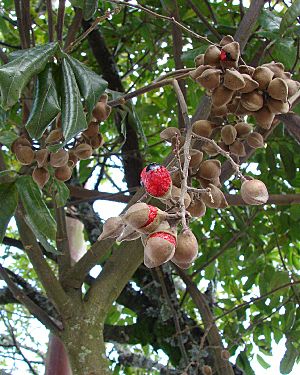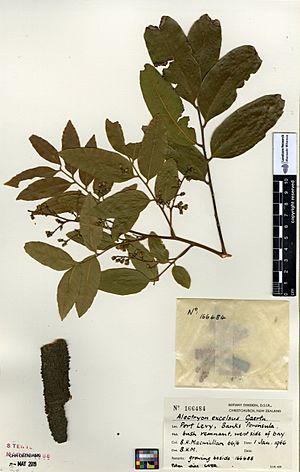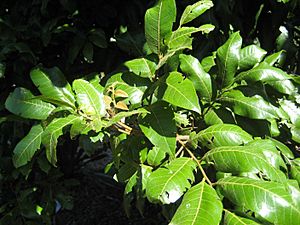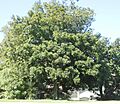Titoki facts for kids
Quick facts for kids Titoki |
|
|---|---|
 |
|
| Scientific classification | |
| Genus: |
Alectryon
|
| Species: |
excelsus
|
The titoki (Māori: tītoki), also known as Alectryon excelsus, is a beautiful tree native to New Zealand. It has shiny leaves and grows in forests near the coast and in lower areas. You can find it across most of the North Island and in parts of the South Island, from Banks Peninsula to central Westland.
This tree was once called the New Zealand oak. However, like many native New Zealand trees, its Māori name, titoki, is now much more common.
Contents
What Does the Titoki Tree Look Like?
The titoki tree is a medium-sized tree that can grow up to 9 metres tall. It has a twisting trunk with smooth, dark bark and branches that spread out. Its leaves are made up of several smaller leaflets.
Leaves and Bark of the Titoki Tree
Adult titoki leaves usually have smooth edges or very few blunt teeth. Their edges often curve downwards. Young leaves, however, have strong teeth and lie flat. The whole leaf can be between 10 and 30 centimetres long. The tree's bark can be pale grey to almost black and feels smooth. Its trunk can grow to 50 centimetres or more across.
Titoki Flowers and Seeds
In spring, the titoki tree produces small purple flowers. It takes about a year for the seeds to fully grow. Female flowers have a small part that looks like a stamen but doesn't have pollen. Male flowers have long, hanging stamens.
The colourful seed starts inside a hairy, woody case called a capsule. When the capsule splits open, it shows a bright red part and a black seed. The black seed is not good to eat.
Where Does the Titoki Tree Grow?
The titoki tree is originally from New Zealand. However, you might find it in other parts of the world too. For example, some titoki trees have been planted along streets in San Francisco.
Titoki's Home in New Zealand
In New Zealand, you can find A. excelsus from the North Island down to the Westland area of the South Island, as far west as Bruce Bay. It often grows in lowland forests, from sea level up to 600 metres high. It also likes coastal forests in the North Island. This tree is seen all over the South Island.
What Kind of Places Does Titoki Prefer?
The titoki tree likes to grow in lowland forest areas and even in exposed coastal spots. It can also be found in sandy plains. In sandy areas, titoki often grows alongside the tawa tree (Beilschmiedia tawa).
How Does the Titoki Tree Grow and Reproduce?
The titoki's ovary develops into a hairy, dense capsule with rusty brown hairs. After about one year, this capsule matures and splits open. This reveals the red, fleshy tissue that surrounds a single large seed.
Titoki Seed Dispersal
Once the capsule opens, the large seed falls to the ground. If it lands in a good spot with the right conditions, it will grow into a new tree. Birds like the tui, kereru, kokako, and blackbirds also help spread the seeds. They eat the fruit and then drop the seeds in other places.
When Does Titoki Flower?
This tree flowers from spring to early summer. Some titoki trees have flowers that are bisexual, meaning they have both male and female parts. However, other titoki trees have separate male and female flowers on different trees.
What Does the Titoki Tree Need to Grow?
The titoki tree loves places with plenty of water, such as wetlands. It prefers moist soil that is rich in nutrients. It also grows well in fertile, sandy soils found along riverbanks and terraces. This plant can grow in conditions ranging from partial shade to full sun.
Who Eats or Harms the Titoki Tree?
Animals That Eat Titoki
The fruit of the titoki tree is often eaten by possums and various birds. Some insects, like a tiny 5-millimetre beetle and a small bronze beetle, enjoy chewing on the bark and leaves. Young titoki trees are also a favourite snack for deer.
Pests and Diseases of Titoki
Parasites mostly affect the leaves and fruit of the titoki tree. White and black moth caterpillars, along with slender worm-like creatures, are often found on the leaves. They damage the tree by eating its leaves. There's also a parasite called the "titoki fruit borer." This borer lives inside the fruit capsule and destroys the seeds by eating them.
How Do People Use the Titoki Tree?
The titoki tree is one of the native trees traditionally planted by the Māori. The Māori people used to eat the pulp from the fruit. The wood of the titoki tree is very flexible and strong. Because of this, it was commonly used to make trainers and wheels.
Titoki Oil and Fragrance
The seeds of the titoki tree were also used to make hair oil. Māori would soak the leaves in this oil to give it a pleasant smell. To make the oil, they would crush the titoki seeds using a special hemp bag, like a tourniquet. Then, they would extract the greenish oil.
Modern Uses of Titoki Fruit
Today, people use the fruit of the titoki tree to make liquor. The fruit gives the alcohol a sweet and slightly bitter taste. This special liquor has been distilled and sent to other countries like Australia, Fiji, Japan, and the United Kingdom.
Images for kids





